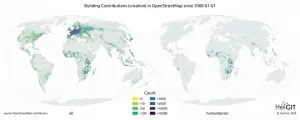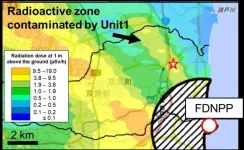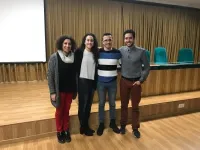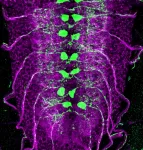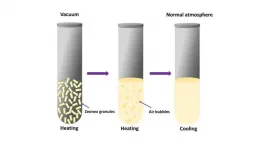(Press-News.org) Researchers have developed a new tool for addressing disseminated intravascular coagulation (DIC) - a blood disorder that proves fatal in many patients. The technology has not yet entered clinical trials, but in vivo studies using rat models and in vitro models using blood from DIC patients highlight the tech's potential.
"DIC basically causes too much clotting and too much bleeding at the same time," says Ashley Brown, corresponding author of a paper on the work. "Small blood clots can form throughout the circulatory system, often causing organ damage. And because this taxes the body's supply of clotting factors, patients also experience excess bleeding. Depending on the severity of DIC, between 40% and 78% of patients with DIC die.
"DIC is associated with a number of other conditions, such as sepsis and cancer - and it is very difficult to treat," adds Brown, who is an assistant professor in the Joint Department of Biomedical Engineering at North Carolina State University and the University of North Carolina at Chapel Hill. "Doctors often focus on trying to treat underlying condition. But if the DIC is bad, doctors face a dilemma: if they treat the bleeding, they'll make the clotting worse; if they treat the clotting, they'll make the bleeding worse. Our goal is to find a clinical intervention that addresses this dilemma. And our results so far are promising."
Brown and her collaborators have developed a technique that makes use of nanogel spheres. The spheres are engineered to bind to a protein called fibrin, which is the main protein found in blood clots. As a result, the spheres will travel through the bloodstream until they reach a blood clot, at which point they will stick to the fibrin in the clot.
These nanospheres are about 250 nanometers in diameter and are porous. In this case, the researchers have loaded the nanospheres with tissue-type plasminogen activator (tPA) - a drug that breaks down clots.
"Based on in vitro testing and testing in a rat model, we found that where you have pre-formed clots (not active bleeding) that the tPA spheres stick to fibrin and break up the clots," says Emily Mihalko, first author of the paper and a Ph.D. candidate in the joint biomedical engineering department. "Breaking up these clots also releases other clot constituents, such as platelets, which evidence suggests may be re-recruited by the body at active clotting sites (i.e., places where there was actually bleeding)."
In one study, the researchers evaluated the use of the tPA and targeted nanospheres in a rat model involving DIC that stems from sepsis. In that study, the researchers found that delivering tPA via the targeted nanospheres eliminated 91 and 93% of the clots found in the heart and lung respectively, and 77% of the clots found in the liver and kidneys.
"We also did in vitro testing using blood plasma from patients with DIC, and found similarly promising results," Brown says.
"We are currently exploring different dosages in the animal model," Mihalko says. "And are doing work to better understand how the particles are distributed in the body and how long it takes before they are cleared by the body - which is important information for addressing safety considerations prior to any clinical trials."
The researchers note that it is too early to put a price tag on any potential treatments that make use of the technology. However, they note that the targeted nanogels mean that treatment would likely involve using smaller doses of tPA than are currently in clinical use.
"The cost of the creating the targeted nanospheres would likely offset the savings from using less tPA, so we suspect it may be comparable to the cost of conventional tPA therapies," Brown says.
INFORMATION:
The paper, "Fibrin-modulating nanogels for treatment of disseminated intravascular coagulation," appears in the journal Blood Advances. The paper was co-authored by Megan Sandry, a former undergraduate in the joint department of biomedical engineering; Nicholas Mininni, an undergraduate in the joint department; Kimberly Nellenbach and Halston Deal, Ph.D. students in the joint department; Michael Daniele, an associate professor of electrical and computer engineering at NC State; Kamrouz Ghadimi, an associate professor of anesthesiology and critical care at Duke University; and Jerrold Levy, professor of anesthesiology and critical care at Duke University.
The work was done with support from the National Science Foundation, under grant 1847488; the National Heart, Lung, and Blood Institute, under grant R01HL146701; a Flash grant from the North Carolina Biotechnology Center; an American Heart Association Predoctoral Fellowship; funding from the U.S. Department of Defense under grant CDMRP W81XWH-15-1-0485; and the National Institute of General Medical Sciences, under grant T32 GM008600.
Brown is the founder of SelSym Biotech, Inc., which focuses on developing injectable hemostatic materials. Levy serves on advisory boards for Instrumentation Labs, Octapharma and Merck.
In recent years, free digital world maps like OpenStreetMap (OSM) have become a vital instrument to support humanitarian missions over the entire world. In disaster management as well as the implementation of the United Nations Sustainability Development Goals (SDGs), geodata compiled by the volunteer mapper community open up new possibilities to coordinate aid interventions and carry out sustainability projects. The mapping data are collected either locally using a smartphone and GPS device or on the basis of satellite images. An international team of researchers led by geoinformation ...
The 10 year anniversary of the Fukushima Daiichi nuclear accident occurs in March. Work just published in the Journal 'Science of the Total Environment' documents new, large (> 300 micrometers), highly radioactive particles that were released from one of the damaged Fukushima reactors.
Particles containing radioactive cesium (134+137Cs) were released from the damaged reactors at the Fukushima Daiichi Nuclear Power Plant (FDNPP) during the 2011 nuclear disaster. Small (micrometer-sized) particles (known as CsMPs) were widely distributed, reaching as far as Tokyo. CsMPs have been the subject of many studies in recent years. However, it recently became apparent that larger (>300 micrometers) Cs-containing particles, with much higher levels of activity (~ 105 Bq), were also ...
The brain's neural activity is irregular, changing from one moment to the next. To date, this apparent "noise" has been thought to be due to random natural variations or measurement error. However, researchers at the Max Planck Institute for Human Development have shown that this neural variability may provide a unique window into brain function. In a new Perspective article out now in the journal Neuron, the authors argue that researchers need to focus more on neural variability to fully understand how behavior emerges from the brain.
When neuroscientists investigate the brain, its activity seems to vary all the time. Sometimes activity is higher or lower, rhythmic or irregular. Whereas averaging brain activity ...
The researchers analysed how Spanish children and adolescents get to school, based on studies examining the commuting patterns of 36,781 individuals over a 7-year period (2010-2017)
Researchers from the University of Granada (UGR) have conducted the most comprehensive study to date on how Spanish children and young people get to school each day, to determine the active commuting rate.
The results showed that, between 2010 and 2017, in the region of 60% of Spanish children and adolescents actively commuted to school, with no significant variations being observed during this period.
The study, which was recently ...
Our brains are complicated webs of billions of neurons, constantly transmitting information across synapses, and this communication underlies our every thought and movement.
But what happens to the circuit when a neuron dies? Can other neurons around it pick up the slack to maintain the same level of function?
Indeed they can, but not all neurons have this capacity, according to new research from the University of Chicago. By studying several neuron pairs that innervate distinct muscles in a fruit fly model, researchers found that some neurons compensate for ...
Scientists have used cutting-edge research in quantum computation and quantum technology to pioneer a radical new approach to determining how our Universe works at its most fundamental level.
An international team of experts, led by the University of Nottingham, have demonstrated that only quantum and not classical gravity could be used to create a certain informatic ingredient that is needed for quantum computation. Their research "Non-Gaussianity as a signature of a quantum theory of gravity" has been published today in PRX Quantum.
Dr Richard Howl led the research during his time at the University of Nottingham's School of Mathematics, he said: "For ...
One early feature of reporting on the coronavirus pandemic was the perception that sub-Saharan Africa was largely being spared the skyrocketing infection and death rates that were disrupting nations around the world.
While still seemingly mild, the true toll of the novel coronavirus, SARS-CoV-2, on the countries of sub-Saharan Africa may be obscured by a tremendous variability in risk factors combined with surveillance challenges, according to a study published in the journal Nature Medicine by an international team led by Princeton University researchers and supported by Princeton's High Meadows Environmental Institute (HMEI).
"Although ...
Adequate spacing between births can help to alleviate the likelihood of stunting in children, according to a new study from the Tata-Cornell Institute for Agriculture and Nutrition (TCI).
In an article published in the Proceedings of the National Academy of Sciences of the United States of America, TCI postdoctoral associate Sunaina Dhingra and Director Prabhu Pingali find that differences in height between firstborn and later-born children may be due to inadequate time between births. When children are born at least three years after their older siblings, the height gap between them disappears.
India's family planning policies have focused on lowering population growth and postponing pregnancy to improve maternal health outcomes. But while the overall fertility rate has fallen as low ...
WASHINGTON -- Researchers have developed an extremely sensitive miniaturized optical fiber sensor that could one day be used to measure small pressure changes in the body.
"Our new pressure sensor was designed for medical applications and overcomes many of the issues of using silica-based fibers," said research team leader Hwa-Yaw Tam from The Hong Kong Polytechnic University. "It is sensitive enough to measure pressure inside lungs while breathing, which changes by just a few kilopascals."
The researchers describe their new optical fiber sensor in The ...
A new X-ray imaging scanner to help surgeons performing breast tumour removal surgery has been developed by UCL experts.
Most breast cancer operations are what are known as conserving surgeries, which remove the cancerous tumour rather than the whole breast. Second operations are often required if the margins (edges) of the extracted tissue are found to not be clear of cancer.
Researchers at UCL, Queen Mary University of London, Barts Health NHS Trust and Nikon used a new approach to x-ray imaging which allows surgeons to assess extracted tissue intraoperatively, or during the initial surgery, giving 2.5 times better detection of diseased tissue in the margins than with standard ...
